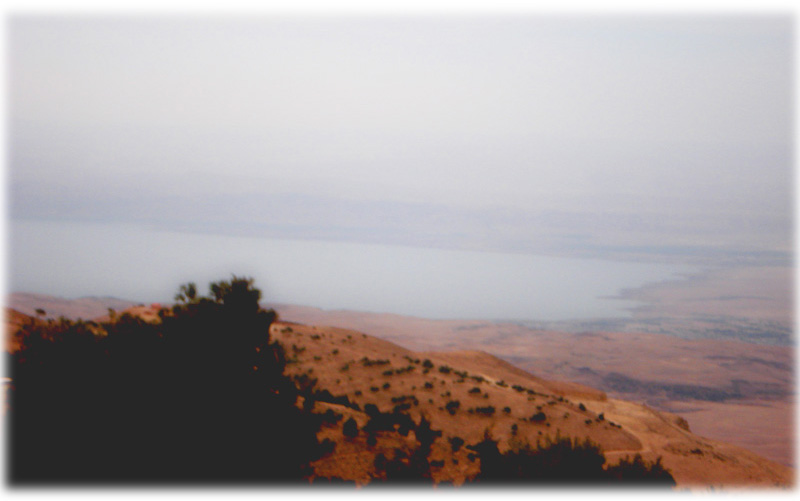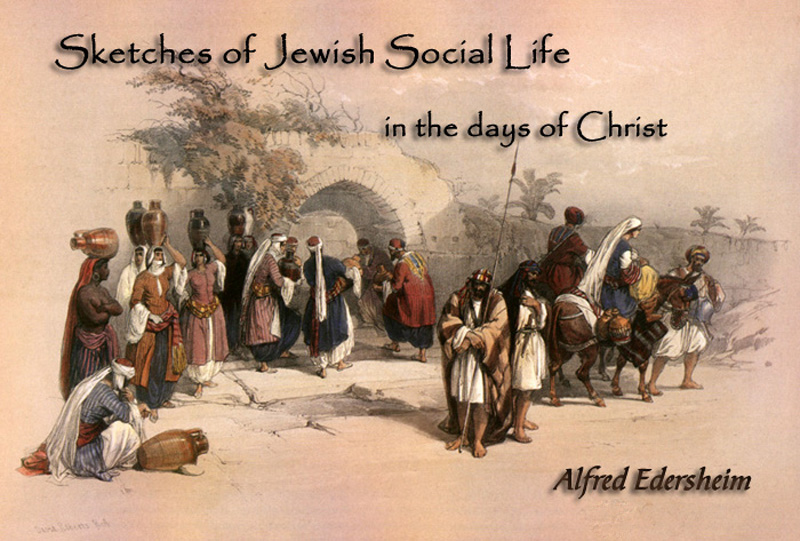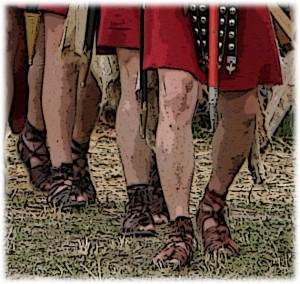Chapter Two, Part One—
The Holy Land
Jews and Gentiles in
THE HOLY LAND
![]()
Going southward from Syria southward, it would have been difficult to have identified the precise spot where the ancient Rabbis would have marked the border of “the land.” The actual boundary lines, although mentioned in four different documents, are not marked in anything like a geographical order; rather ritual theological questions determined the border more than actual geographical landscape. For the Rabbis, the precise limits of Palestine were important only so far as those limits affected the religious obligations or privileges of a district. In this respect any city under heathen influence would have been excluded as not being within the boundaries of the Palestine. Thus the environs of Ascalon, the wall of Caesarea, and that of Acco, were all reckoned within the boundaries of Palestine, though the cities themselves were not. Indeed, viewing the question from a theological perspective, Palestine was to the Rabbis simply “the land,”3 with all other territories being designated as “outside the land.” In the Talmud, the expression “Holy Land,” so common among later Jews and Christians, does not occur even once. Indeed, the only passage in Scripture in which the term is used is Zechariah 2:12, (or rather 2:16 in the Hebrew original.)
The descriptor, holy, would have been regarded as an unnecessary since Rabbinic Palestine was regarded not only as holy, but the only holy ground to the utter exclusions of all other countries. However, the Rabbis did mark within its boundaries an ascending sale of ten degrees of sanctity, rising from the bare soil of Palestine to the most holy place in the Temple (Chel. i. 6-9). Everything “outside the land” was darkness and death. The very dust of a heathen country was unclean, and it defiled by contact. It was regarded like a grave, or like the putrescence of death. If a spot of heathen dust had touched an offering, it must at once be burnt.
More than that, if by mischance any heathen dust had been brought into Palestine, it did not and could not mingle with that of “the land,” but remained to the end what it had been—unclean, defiled, and defiling everything to which it adhered. This will cast light upon the meaning conveyed by the symbolical directions of our Lord to His disciples (Matt 10:14), when He sent them forth to mark out the boundary lines of the true Israel—“the kingdom of heaven,” that was at hand:
“Whosoever shall not receive you, nor hear your words, when ye depart out of that house or city, shake off the dust of your feet.”
In other words, they were not only to leave such a city or household, but it was to be considered and treated as if it were heathen, just as in the similar case mentioned in Matthew 18:17. All contact with such must be avoided, all trace of it shaken off, and that, even though, like some of the cities in Palestine that were considered heathen, they were surrounded on every side by what was reckoned as belonging to Israel.
[clearcol]
| Syria as an Outer Palestine |
T“he The Mishnah (Shev, vi. 1; Chall. iv. 8 ) marks, in reference to certain ordinances, “three lands” which might equally be designated as Palestine, but to which different ritual regulations applied. The first comprised, “all which they who came up from Babylon took possession of in the land of Israel and unto Chezib” (about three hours north of Acre); the second, “all that they who came up from Egypt took possession of from Chezib and unto the river (Euphrates) eastward, and unto Amanah” (supposed to be a mountain near Antioch, in Syria); while the third, seemingly indicating certain ideal outlines, was probably intended to mark what “the land” would have been, according to the original promise of God, although it was never possessed to that extent by Israel.
For our present purpose, of course, only the first of these definitions must be applied to “the land.” We read in Menachoth vii. 1: “Every offering, whether of the congregation or of an individual (public or private), may come from ‘the land,’ or from ‘outside the land, be of the new product (of the year) or of old product, except the omer (the wave-sheaf at the Passover) and the two loaves (at Pentecost), which may only be brought from new product (that of the current year), and from that (which grows) within ‘the land.’”
To these two, the Mishnah adds in another passage (Chel. i. 6) also the Biccurim, or first-fruits in their fresh state, although inaccurately, since the latter were likewise brought from what is called by the Rabbis Syria,7 which seems to have been regarded as, in a sense, intermediate between “the land” and “outside the land.”
The term Soria, or Syria, does not include that country alone, but all the lands which, according to the Rabbis, David had subdued, such as Mesopotamia, Syria, Zobah, Achlab, etc. It would be too lengthy to explain in detail the various ordinances in regard to which Soria was assimilated to, and those by which it was distinguished from, Palestine proper. The preponderance of duty and privilege was certainly in favour of Syria, so much so, that if one could have stepped from its soil straight to that of Palestine, or joined fields in the two countries, without the interposition of any Gentile strip, the land and the dust of Syria would have been considered clean, like that of Palestine itself (Ohol. xviii. 7).
There was thus around “the land” a sort of inner band, consisting of those countries supposed to have been annexed by King David, and termed Soria. But besides this, there was also what may be called an outer band, towards the Gentile world, consisting of Egypt, Babylon, Ammon and Moab, the countries in which Israel had a special interest, and which were distinguished from the rest, “outside the land,” by this, that they were liable to tithes and the Therumoth, or first-fruits in a prepared state. Of course neither of these contributions was actually brought into Palestine, but either employed by them for their sacred purposes, or else redeemed.
Maimonides arranges all countries into three classes, “so far as concerns the precepts connected with the soil”—“the land, Soria, and outside the land”; and he divides the land of Israel into territory possessed before and after the Exile, while he also distinguishes between Egypt, Babylon, Moab, and Ammon, and other lands (Hilch. Ther. i. 6). In popular estimate other distinctions were likewise made. Thus Rabbi Jose of Galilee would have it (Bicc. i. 10), that Biccurim8 were not to be brought from the other side of Jordan, “because it was not a land flowing with milk and honey.”
But as the Rabbinical law in this respect differed from the view expressed by Rabbi Jose, his must have been an afterthought, probably intended to account for the fact that they beyond Jordan did not bring their first-fruits to the Temple. Another distinction claimed for the country west of the Jordan curiously reminds us of the fears expressed by the two and a half tribes on their return to their homes, after the first conquest of Palestine under Joshua (Josh 22:24, 25), since it declared the land east of Jordan less sacred, on account of the absence of the Temple, of which it had not been worthy. Lastly, Judaea proper claimed pre-eminence over Galilee, as being the centre of Rabbinism. Perhaps it may be well here to state that, notwithstanding strict uniformity on all principal points, Galilee and Judaea had each its own peculiar legal customs and rights, which differed in many particulars one from the other.
What has hitherto been explained from Rabbinical writings gains fresh interest when we bring it to bear on the study of the New Testament. For, we can now understand how those Zealots from Jerusalem, who would have bent the neck of the Church under the yoke of the law of Moses, sought out in preference the flourishing communities in Syria for the basis of their operations (Acts 15:1).
There was a special significance in this, as Syria formed a kind of outer Palestine, holding an intermediate position between it and heathen lands. Again, it results from our inquiries, that, what the Rabbis considered as the land of Israel proper, may be regarded as commencing immediately south of Antioch. Thus the city where the first Gentile Church was formed (Acts 11:20, 21); where the disciples were first called Christians (Acts 11:26); where Paul so long exercised his ministry, and whence he started on his missionary journeys, was, significantly enough, just outside the land of Israel.
Immediately beyond it lay the country over which the Rabbis claimed entire sway.
Travelling southwards, the first district which one would reach would be what is known from the gospels as “the coasts (or tracts) of Tyre and Sidon.” Mark describes the district more particularly (7:24) as “the borders of Tyre and Sidon.” These stretched, according to Josephus (Jewish War, iii, 35), at the time of our Lord, from the Mediterranean towards Jordan. It was to these extreme boundary tracts of “the land,” that Jesus had withdrawn from the Pharisees, when they were offended at His opposition to their “blind” traditionalism; and there He healed by the word of His power the daughter of the “woman of Canaan,” the intensity of whose faith drew from His lips words of precious commendation (Matt 15:28; Mark 7:29). It was chiefly a heathen district where the Saviour spoke the word of healing, and where the woman would not let the Messiah of Israel go without an answer. She herself was a Gentile. Indeed, not only that district, but all around, and farther on, the territory of Philip, was almost entirely heathen. More than that, strange as it may sound, all around the districts inhabited by the Jews the country was, so to speak, fringed by foreign nationalities and by heathen worship, rites, and customs.
[clearcol]


